#emperor yongle
Explore tagged Tumblr posts
Text
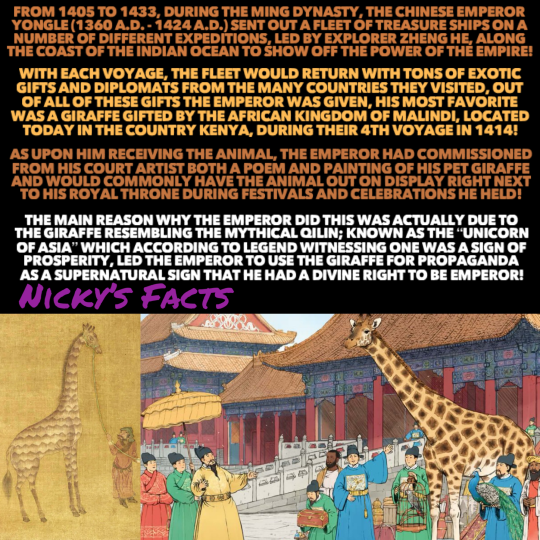
Another classic example of Giraffe diplomacy, works every time!
🇰🇪🦒🇨🇳
#history#giraffe#ming dynasty#emperor yongle#qilin#chinese history#malindi#zheng he#1400s#royalty#animal history#propaganda#age of discovery#exotic pets#mythical creatures#african history#kenya#diplomacy#historical figures#animals#ming china#royal history#cute animals#gifts#nickys facts
8 notes
·
View notes
Text
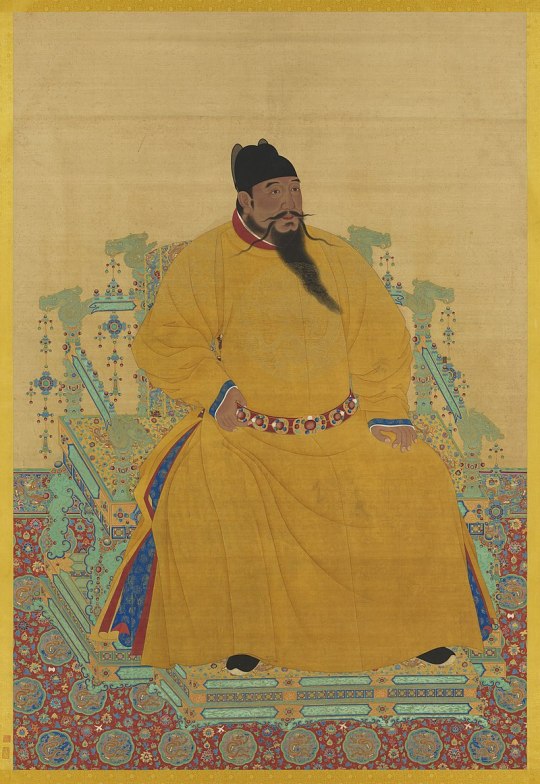
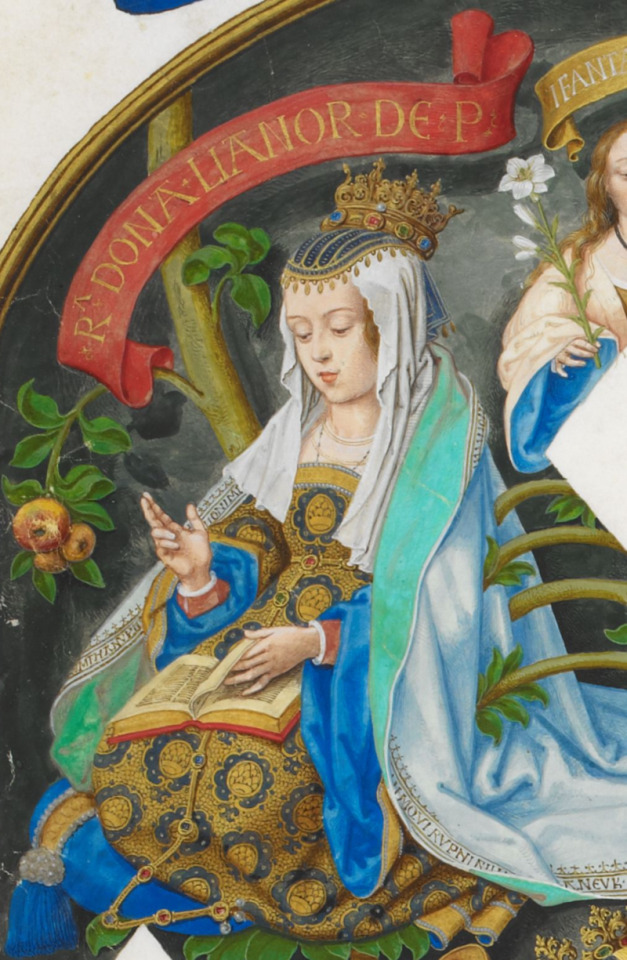
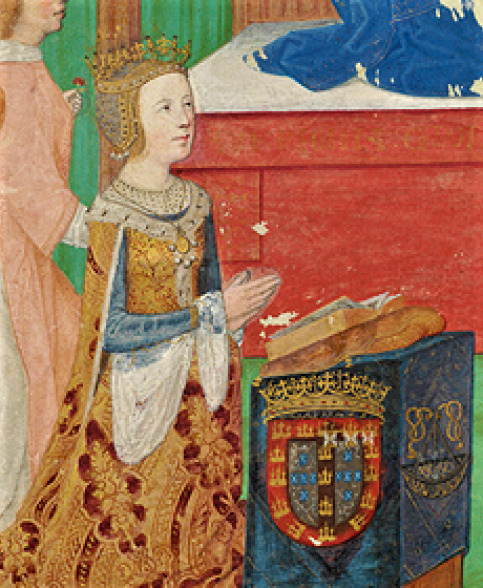
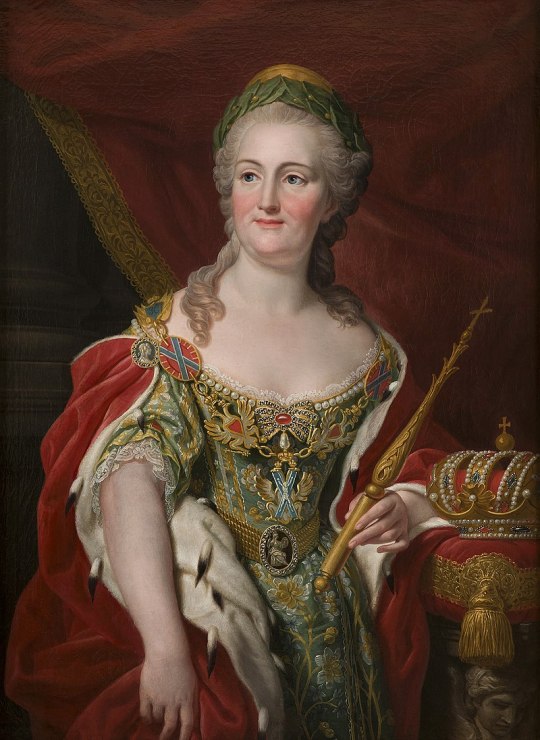
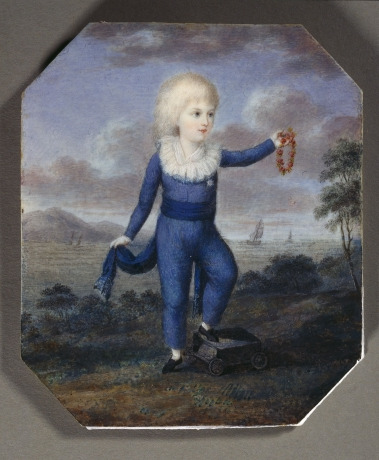
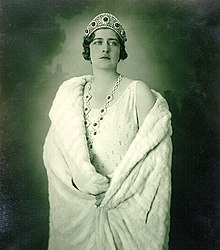

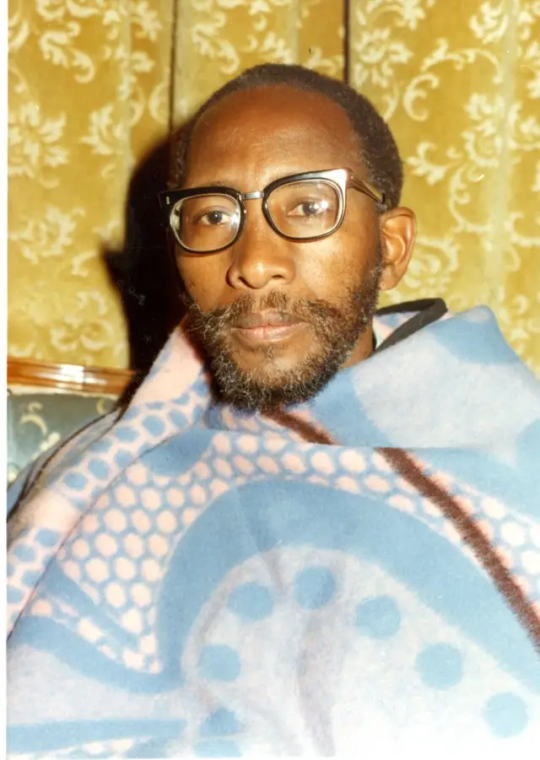


Royal Birthdays for today, May 2nd:
Yongle Emperor, Emperor of China, 1360
Eleanor of Aragon, Queen of Portugal, 1402
Eleanor of Viseu, Queen of Portugal, 1458
Catherine II, Empress and Autocrat of All the Russias, 1729
Alberto, Prince of Naples and Sicily, 1792
Helen of Greece and Denmark, Queen Mother of Romania,1896
Faisal II, King of Iraq, 1935
Moshoeshoe II, King of Lesotho, 1938
Nathalie of Sayn-Wittgenstein-Berleburg, German Princess, 1975
Charlotte of Wales, British Princess, 2015
#princess charlotte#eleanor of aragon#eleanor of viseu#catherine ii#catherine the great#helen of greece and denmark#yongle emperor#prince alberto#faisal ii#Moshoeshoe II#Nathalie of Sayn-Wittgenstein-Berleburg#royal birthdays#long live the queue
14 notes
·
View notes
Text
what happens when the pint-sized copy of gojo satoru fails the quiz his dad helped him review?

the door slams.
not shuts. not closes. slams—with the full, righteous fury only a small, betrayed child can muster. a tiny, furious body with too much emotion and too little upper-body strength, using every ounce of indignation to make an entrance.
a backpack ricochets off the hallway wall, landing with a sad, almost pitiful plop. you pause mid-slice, knife hovering above half a strawberry on the cutting board, sugar-dusted fingertips twitching.
from the living room, satoru blinks behind a pair of wire-framed reading glasses—askew on the bridge of his nose, balancing in the space where his usual sunglasses would sit. he’s sprawled lazily on the floor, legs kicked up onto the coffee table, wearing a pair of navy blue pajamas patterned with tiny mochi cats. an open manga flutters against his chest.
he doesn’t sit up. not yet. just slowly turns his head toward you, peering over the edge of the couch with the exact caution of prey sensing a distant predator.
“...was that the wind?” he asks, voice very hopeful.
you lift a brow, flicking your eyes toward the front hallway.
“baby,” you deadpan, “we don’t get wind indoors.”
and then—like a summoned curse echoing from the depths of a broken heart—a sound shatters the air.
a wail.
high-pitched. raw. as if the whole world had crumbled under a pair of light-up velcro sneakers. you barely have time to process it before—
“mamaaaaaa!! daddyyyyyyyy!!”
satoru flinches like he’s taken physical damage. the manga slips off his chest and hits the floor with a soft thup. both your heads snap toward the hall just in time to witness the grand, devastating arrival of your son.
he’s tiny. flushed pink from the cold or from his tears, it’s hard to tell. his white hair is a mop of fluffy chaos—tufts sticking up where little fingers must’ve raked through it on the playground, a single rebellious cowlick curled toward the sky like a question mark. cheeks blotchy. nose red. lower lip trembling so hard it casts its own shadow.
and he’s crying.
not sniffles. not whimpers.
crying. open-mouthed, sob-shattered wails that rattle the windows and tug at your heart. arms flailing, body stumbling forward like a tragic protagonist in a historical drama. his sleeves are too long—he must’ve tugged at them all day—and now they flap as he wipes his eyes with the cuffs, trailing streaks of moisture across the fabric.
your knife is already down. you round the kitchen island in record time and crouch, arms open.
“baby, what’s wrong?!”
he doesn’t just run into your arms—he launches himself, full body-weight, like a little cannonball of despair. his backpack thumps against your hip as he buries his face in your chest.
“i didn’t get ice creeeeeeam—!!”
you blink.
“...oh,” satoru says from behind you, having finally peeled himself off the floor. he crouches beside you, pajama pants riding up a little around the ankle. his hair’s a fluffy mess, eyes wide behind his reading glasses, mouth open like he’s still buffering. “you didn’t get what?”
“ice cream,” your son sobs, voice thick and hiccuping. “everybody got some ‘cause they passed the quiz and i didn’t—even though we studied!! even though we did the ming dynasty thing and daddy wore the stupid kimono!!!”
“it wasn’t stupid,” satoru frowns, indignant. “it was authentic.”
you pinch the bridge of your nose. “sweetheart, slow down. what quiz?”
“the history one,” your son says, sniffling miserably. “with the ming dyna—hic—sty and emperor yongle and daddy said if i remembered the porce… porcelain stuff i’d get full marks…”
you and satoru lock eyes.
oh.
that quiz.
the living room flashes back in your mind—satoru in a patterned bathrobe tied with your silk scarf, chopsticks in his hair, declaring himself emperor of all snacks. your son clutched his stomach from laughing so hard he rolled off the couch. satoru called it “immersive education.”
apparently... it wasn’t effective.
your son’s lower lip quivers again. he pulls back slightly to sniff, his little brows furrowed, his voice small and wounded. “it’s not fair… daddy said he was the best at history and he lied and now everyone got to go to the cafeteria for ice cream and i had to stay and read with ms. matsuda and it was boring and i don’t even like maps—”
satoru visibly stiffens. his head tilts.
“...oh no,” he mutters. “it was geography?”
you stare at him.
“wait,” you say slowly, turning back to your son, “you did the ming dynasty for geography?”
he pauses.
his eyes widen. he turns to satoru. horror dawns.
“...what?”
satoru clears his throat. tugs at the collar of his mochi cat pajama top.
“...oops?”
“daddy!!!” your son bellows, fists flying. he punches satoru’s arm with all the fury in his tiny frame. it’s like being attacked by a particularly angry cloud. satoru lets himself be dramatically thrown back onto the floor, flopping like a fish.
“argh!! fatal blow! betrayal by my own bloodline!!”
your son sniffles, shoulders rising and falling, too tired to be mad but too heartbroken to forgive. he plops back onto the floor with a heavy sigh, pulling his sleeves over his hands like a soggy little dumpling of grief.
“...so i don’t get any ice cream.”
from the floor, satoru grins.
“nope. you’re getting a whole bucket.”
you whirl on him. “satoru—!”
“what? he suffered, he deserves it.” satoru pushes his glasses up and cracks his knuckles. cursed energy begins to shimmer faintly around him, blurring the air like heat off pavement. “i’ll be back in fifteen. or maybe two. actually—let’s make it one.”
you gape. “you’re using your limitless to get him ice cream—?”
“and this is why you married me,” he says with a wink, and then—
pop.
he’s gone. air displaced in a puff of cool wind and sparkles.
you sigh. your son leans into you, cheek pressed to your shoulder. you wrap your arms around him gently, brushing your fingers through his hair. still soft from this morning’s brushing. a few crumbs from lunch clinging to the ends.
he tugs your shirt, voice muffled.
“...mama,” he says, “if i cry again, can i eat more scoops?”
you pause.
squint down at him. “that depends. are the tears real?”
he considers. long pause. then, with the gravitas of a stage actor, he pinches his nose and starts fake crying—loud, wobbly sobs that rock his whole body.
and then—pop.
satoru’s back. disheveled, pajama sleeves windblown, glasses askew, and arms cradling an absurdly massive neon plastic tub that smells like every ice cream flavor ever invented. it’s glowing. it might actually be radioactive.
your son stops fake-crying mid-sob.
“…score.”
satoru beams. “for my little emperor of the ming dynasty!”
you all end up piled on the couch, one tangled mass of pajama legs and sticky fingers. strawberry slices forgotten on the counter. your son curled between you both, spoon held like a royal scepter, dribbling rainbow cream down his chin as he proclaims flavor rankings with the gravitas of a judge.
“your majesty,” satoru intones, spoon raised high, “may i present the cookie dough scrolls of diplomacy.”
you roll your eyes fondly, head resting on satoru’s shoulder. “you’re such an idiot.”
he kisses your cheek, smiling.
“uh huh. but i’m your idiot.”
your son silently shoves a spoon in both your mouths.
he’s still sulking. a little. but the betrayal has been soothed by frozen sugar, warmth, and the fact that tomorrow, daddy promised to stage the tang dynasty.
correct subject pending.

a/n : i need to have his babies so bad nobody understands 😔🥀 yes you can't convince me he wouldn't teleport just to get his kids ice cream even if he's wearing ridiculous pajamas <3
#౨ৎ — flash reports#gojo fluff#gojo satoru#gojo x reader#gojo x female reader#satoru gojo x reader#gojo satoru x reader#reader insert#gojo satoru x y/n#gojo x you#satoru gojo x you#gojo satoru x you#dad!gojo
1K notes
·
View notes
Text

Depiction of a giraffe brought from Somolia to China in the 12th year of the reign of Emperor Yongle (1415 AD)
193 notes
·
View notes
Text
[Hanfu · 漢服]Chinese immortal Hanfu <电母/Mother of Lightning> Based On Yuan Dynasty Taoist Temple Mural<永乐宫/Yongle Palace>
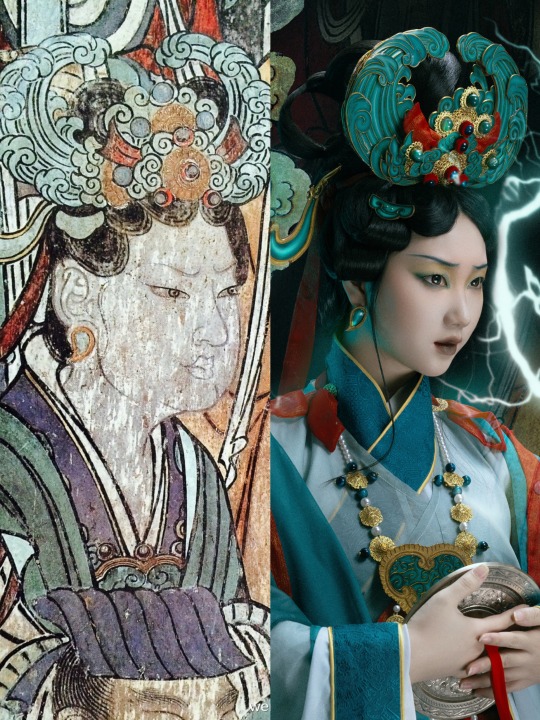
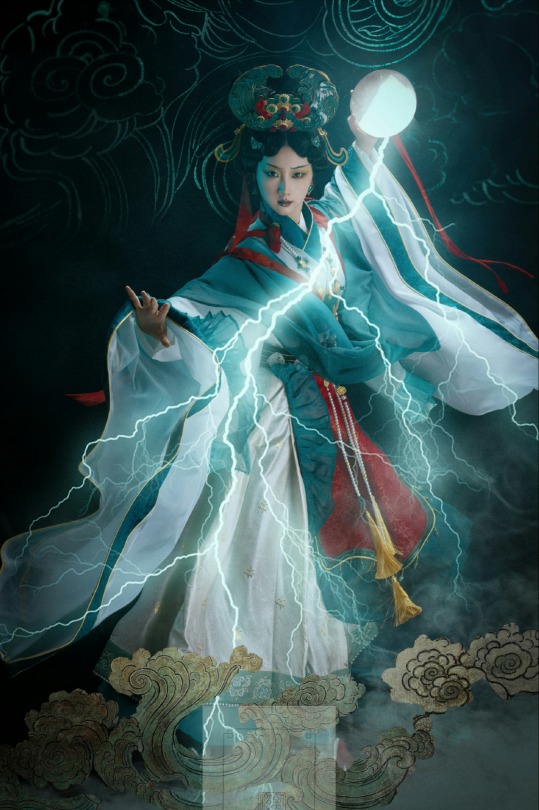
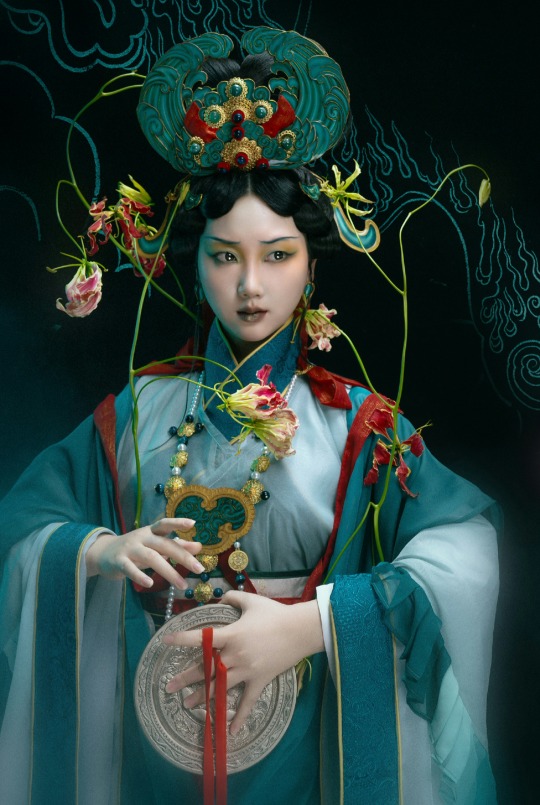
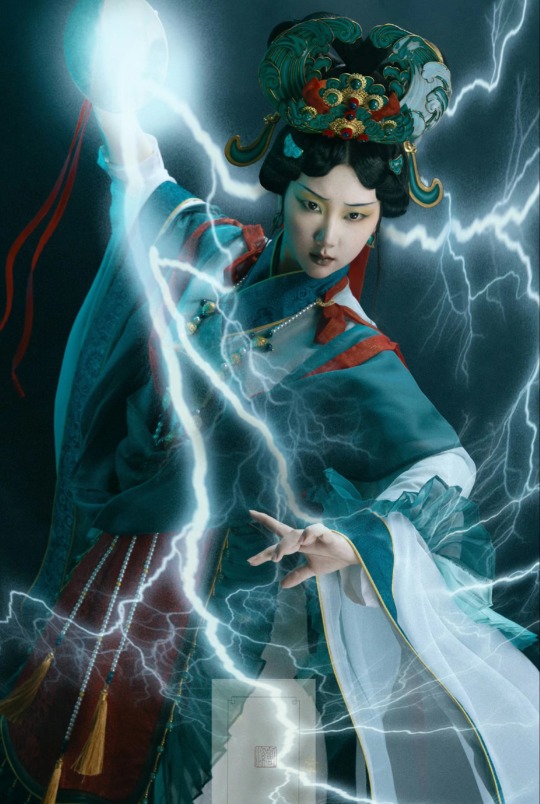
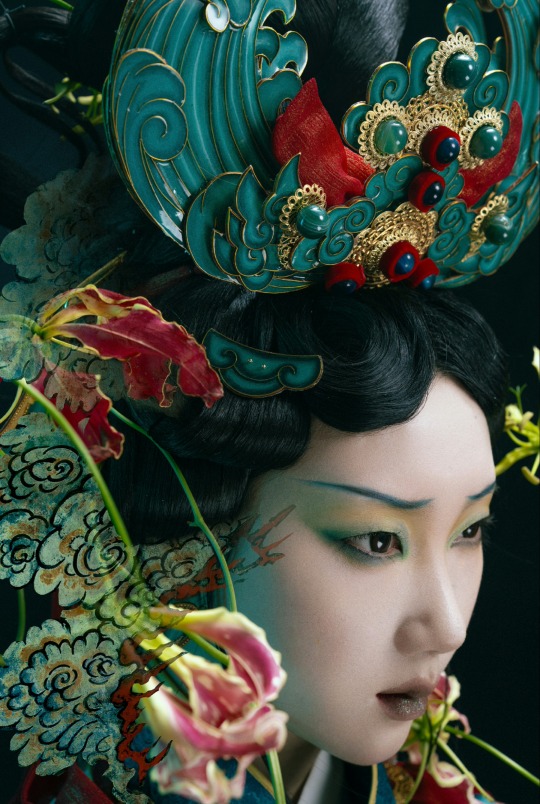
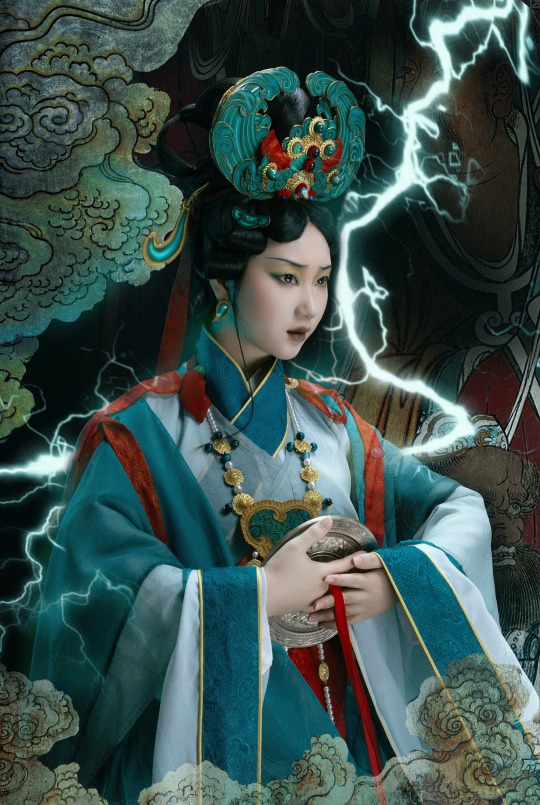
【Historical Artifacts Reference 】:��� China Yuan Dynasty Taoist Temple 永乐宫/Yongle Palace Mural<电母/Mother of Lightning>

⚡【电母/Mother of Lightning】⚡
电母/Dianmu (Chinese: 電母; pinyin: Diànmǔ; lit. 'Mother of Lightning'), also known as Leizi, is the Chinese goddess of lightning, who is said to have used flashing mirrors to send bolts of lightning across the sky.
She is married to Leigong/雷公, the god of thunder. She is one of the gods who work together to produce the phenomena of thunder. Other companions are Yun Tong (Yún Tóng, 云童, lit. the "Cloud Youth/Kid"), who whips up clouds, and Yu Shi/雨师 ("Rain Master") who causes downpours by dipping his sword into a pot. Roaring winds rush forth from a type of goatskin bag manipulated by Fengbo/风伯 ("Earl of Wind/Wind Uncle"), who was later transformed into Feng Po Po ("Old Lady Wind").
Legend
Dianmu was once a human, who lived with her mother. One day, she was dumping rice husks, because they were too hard for her mother to eat. When the short-tempered thunder god Leigong saw her dumping the husks out, he thought she was wasting food, so he killed her. When the Jade Emperor found out, he was infuriated at Leigong's careless murder. The Jade Emperor revived Dianmu, making her a goddess. Dianmu was made to marry Leigong, who took on the responsibility of caring for her. Dianmu's job is now to work with Lei Gong. She uses mirrors to shine light on the Earth, so Leigong can see who he hits and makes sure they aren't innocent. This is why lightning comes before thunder.
In other depictions
Dianmu also appears in Wu Cheng'en's late 16th-century novel, the Journey to the West; she appears during the events of the Slow Cart Kingdom (車遲國, Chechi), where three 'Animal Strength/Power Immortals', "Tiger Strength", "Deer/Elk Strength" and "Goat/Antelope Strength", three demons who disguised themselves as Taoist magicians to deceive the King of the Kingdom of Chechi, by means of having ended a seemingly-endless drought through the means of a legitimate magic tablet that can control the weather by summoning gods in control of various aspects of the weather, including Dianmu, accompanied by Yún Tóng (云童, lit. the "Cloud Youth"). Once Sun Wukong interrupts the summons, Dianmu and her fellow weather deities help the Buddhists instead of the demons in their rain-making competition.
————————
📸Photography post-production :@小何力
👗Hanfu & 👑Crown:@雁鸿Aimee
💄 Makeup:百丽 (临溪摄影)
👭Model:@清音音音音
🔗 Weibo:https://weibo.com/1615560544/O267AzTqM
————————
#chinese hanfu#immortal hanfu#电母/Mother of Lightning#Chinese mythology#hanfu#hanfu accessories#hanfu_challenge#chinese traditional clothing#china#chinese#hanfu girl#hanfu fashion#chinese history#china mythology#chinese style#漢服#汉服#中華風
481 notes
·
View notes
Text
eunuch rating system: part 2 electric boogaloo! part 1 based on the original post by @welcometothejianghu wherein i continue to rate REAL historical chinese eunuchs! this is a non-exhaustive list and there's honestly no metric to it. i just pick the guys i like.
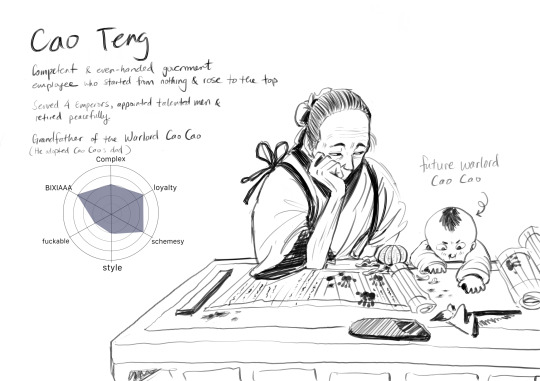
Han Dynasty (yes, again. the Han was like 400 years long lol) Cao Teng was a pretty normal guy whose biggest claim to fame is his extremely infamous grandson, Cao Cao. Because of this, Cao Teng is the only enunch in chinese history to get a royal title; Emperor Gao of Wei, which was granted posthumerously through Cao Cao’s grandson Cao Rui.
Cao Teng was a good judge of character who promoted a bunch of famous people, one of whom was a guy who had even tried to impeach him previously. After 30 years of service, he retired, got married, and adopted a son.
i decided to put him on the list because the common perception of the eunuch is a "mutilated" man living a lonely, unfulfilled life. What is often left out is they are highly motivated people who excel at their jobs, exert a lot of influence, and are able to have families and leave a legacy.
the majority of eunuchs came from poor families, and serving at the palace gave them an opportunity to obtain wealth, status and an education they would otherwise never have access to. it does require an unimaginably painful sacrifice, but that shouldn't be the only thing that defines them.
Cao Teng's hard work benefited his entire clan and lifted them out of poverty. But there was a complex interplay between him being a venerable ancestor, and someone marked by the stigma of castration. I imagine there was something bittersweet here for Cao Teng, knowing that he had done so much for his family, but they would rather he didn't exist.
Cao Cao was able to become a prime minister because of the wealth, connections, and education earned by his grandfather. At the same time, he appeared to resent him. The source of his ancestory was a sore spot which was repeatedly brought up by his political enemies to discredit him, something he never commented directly on or attempted to defend.
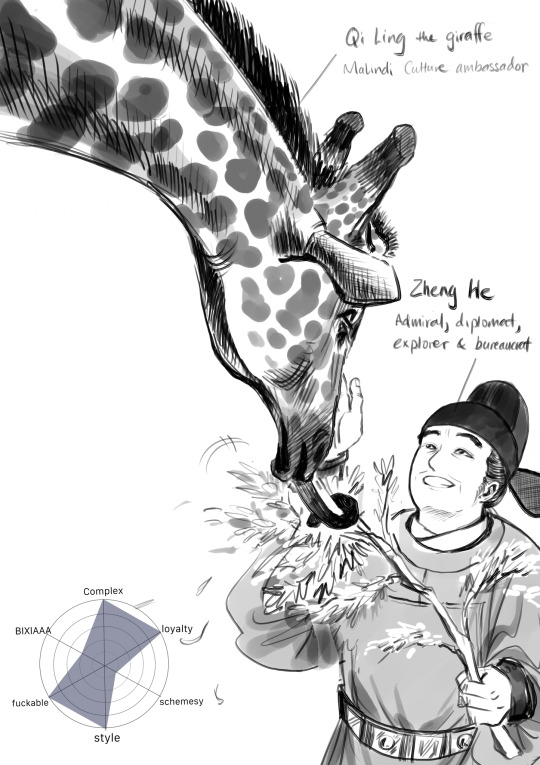
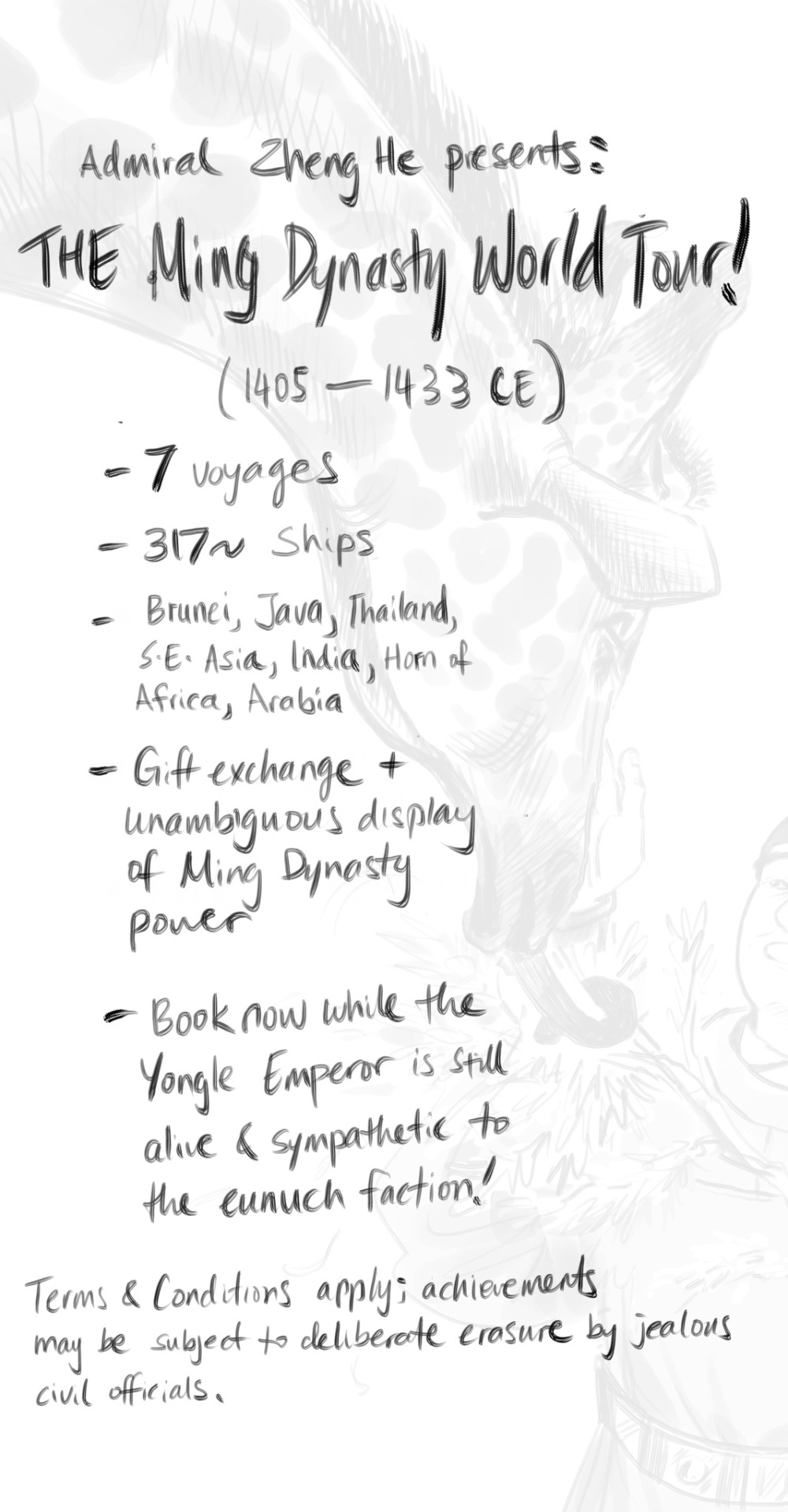
ming dynasty
MAKE SOME FUCKING NOISE FOR THE COOLEST PERSON IN THE MING DYNASTY!!!! actually scratch that, MAKE SOME FUCKING NOISE FOR THE COOLEST PERSON IN CHINESE HISTORY, PERIOD.
Zheng He was born Ma He to muslims living in Yunan, which was ruled by Mongols at the time. He was captured by the Ming army between the age of 10-14, castrated, and given to the young Yongle Emperor as a servant. Incredibly enough, he was like "no hard feelings mate" and went on to work in EVERY SINGLE JOB. and kick absolute ass in ALL OF THEM. he started out as a soldier on the northern frontier (the toughest place to serve, that was where all the border conflicts were) and fought in several campaigns with the future emperor, distinguishing himself and earning the emperor's trust.
I originally had him drawn in a more stereotypically "heroic" pose, by all accounts he was a tough guy who "walked like a tiger", and while the main purpose of the Ming voyages were diplomatic, he didn't shy away from violence. (he fought PIRATES. like a fucking shonen protagonist). in the end i decided to go with a picture that showcases less celebrated but equally important leadership qualities like curiosity, patience and discipline. I also want to point out that he wasn't the only eunuch on the trip, around half of the commanding officers were also eunuchs. He wasn't an exception to the rule but rather the face of a largely ignored majority; complicated people who were making the most of a difficult job.
Notes: the giraffe he brought back didn't have a name (at least not on record), but the Ming thought it was a qilin (kinda like a chinese unicorn) and i thought that would be an adorable name for a giraffe.
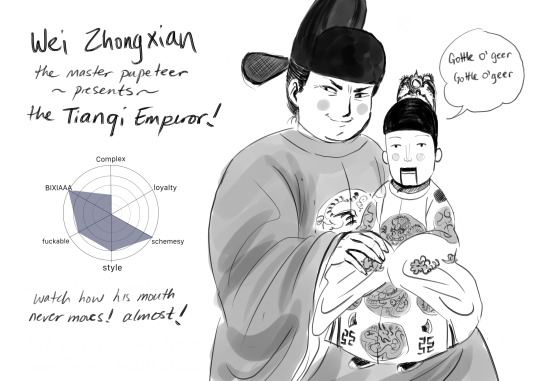
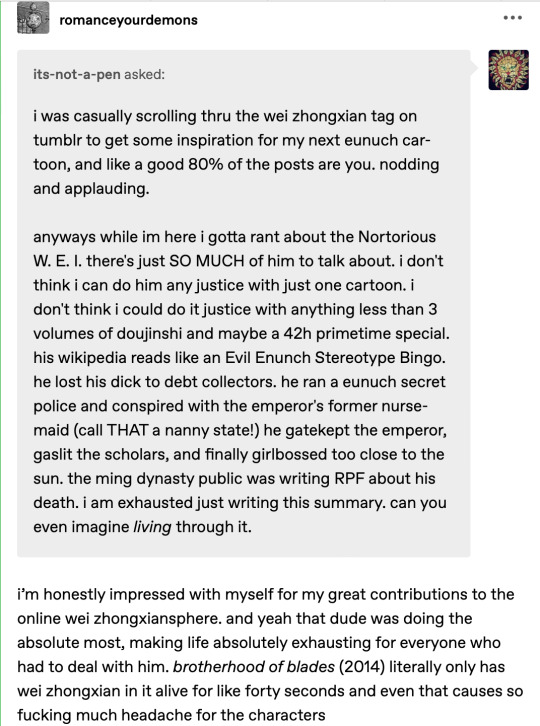
Ming Dynasty
i feel like we've had too much nuance, so lets finish this list off with a properly corrupt and scheming enunch! Wei Zhongxian castrated himself at age 21 to escape his gambling debts, and it unleashed his potiential like Rock Lee removing his leg weights. once inside the palace, he started out as a minor kitchen hand but managed to hustle his way to being the right hand of the emperor, who was an indifferent ruler that prefered woodworking to running a country. for this reason, I decided to make him a ventriloquist dummy.
Wei Zhongxian then proceeded to go on an extravagant and over-compensating ego trip. actually, it was more like a 40-year-long, olympic worthy, ego-long jump. things came to a terrible end when he tried to stage a coup (it failed and he decided not to hang around the capital, and go hang on some rafters instead). by then, decades of corruption had weakened the Ming, the emperor's only son got exploded in horrible incident that also wiped out most of the Ming Dynasty munitions--and what's this? here comes the Qing Dynasty with a steel chair!!!! notes: I decided to make Wei Zhongxian's design a human version of my cat, because he is also an incredibly devious but rather low-wisdom individial.
196 notes
·
View notes
Text
The Real World Influences of Kingdoms and Empires: II
And here's an example of what you'll find in the FREE Patreon posts!!!
Unlike the first one, this is specifically only for the Belthean Empire as a unified polity. In the next post in the Real World Influences, I'll talk about the Old Kingdoms in the empire that used to be independent.
Belthean Empire
The Holy Belthean Empire, at least societally and culturally is inspired from a mix of both Imperial China and the Achaemenid Empire in core with lots of Roman Empire in the exterior.
I wanted to create an empire that was advanced culturally, militarily, and scientifically while also boasting a diverse and cosmopolitan background. And to that end I settled on specifically the Tang Dynasty and the empire of Cyrus the Great. The Roman Empire is already known for this of course, but not in the way the other two were (depending on time period of course).
Some Belthean Emperors were also inspired by entire Dynasties of Imperial China!
For instance, Emperor Garland the Founder is pretty much the Qin Empire. He personified the violent rise of the Qin, their brutality, and his historic feat of uniting his people under one nation.
His son however, Emperor Daerin I is the early Han Dynasty instead, using more peaceful and careful methods of uniting the people after the brutality that brought his people together in the first place. His philosophy is also studied and followed by the Master-Scholars of Jelaytha, and is very reminiscent of teachings of Confucius. We'll see more when Master Feren teaches us.
Emperor Valerion is the Song Dynasty, who helmed the Belthean Empire's path to more intellectual pursuits. This min-max focus led to the establishment of the Imperial Libraries, the social change of the nobility shifting to becoming scholar-nobles for a generation in order to join the government because of the new civil service examination system, and advancements in technology and medicine with many new inventions being made during this period.
Emperor Elric I was inspired from the Yuan Dynasty. Constant wars, battles, heavy taxation, and still using the intellectual systems created by the previous ruler (dynasty) it all came to an end with a massive rebellion.
Emperor Cenric however, is the only emperor on this list that isn't inspired by the dynasties. He is instead inspired from Ahoska the Great's legend of pacifism after a brutal conquest. His story instead deals with the literal nuking of the City of Farghas.
His son, Emperor Saldwin, is mostly associated/inspired by the Ming Dynasty. His major naval expedition, the incredible international prestige gained, and the beginning of a world superpower was created with his reign. The tribute and supplication of the powers around him, the incredibly effective and brutal methods of suppression of traitors and enemies, and the pivot to keeping the peace later on while having been militaristic earlier are similar in vein of the Yongle Emperor of Ming.
And now we have Emperor Elric II, the start of the three generations that are considered by me to be of the early half of the Tang Dynasty. If his father can be considered Trajan, Elric II can be considered Hadrian. Elric II did his best to solidify the gains his father conquered, and honorably upheld the multiple treaties signed. Under his reign, a true golden age descended upon the empire.
Emperor Daerin II inherited a strong, peaceful, stable, rich, and thriving empire. He also inherited when he was nine years old. His mother, who was supposed to be the first empress of the Beltheans, had died giving birth to him, and Daerin II's uncles died from freak accidents. So when the previous emperor, his grandfather died clutching his heart in the fables gardens of Emperor's Circle, a child took the helm of the strongest nation of the world. This led to a gaping hole in the political landscape of the empire, allowing for factions to wage wars of intrigue, using assassinations, intimidation, blackmail, and seduction. It is only because of the regent, his father-in-law, that the empire did not openly give way to civil war. Daerin II's excesses, and the regents, politicking, and young age of his coronation, are all inspired by the late Han Empire, that gave way to the Three Kingdoms Period.
And finally, Emperor Otto. I'd rather not spoil anything regarding this man. Our maternal grandfather is a complex figure, one who left his mark upon history, and whose presence will still be felt even after he passes. The empire has enjoyed an unprecedent era of peace and progress that started from Emperor Otto's grandfather, Emperor Elric II. His reign enjoyed an unbroken period of peace that lasted almost 40 years, and Otto's own father Emperor Daerin II, waged what the empire considered a minor conflict on the border with the Tripartite Alliance. The empire didn't face major mobilization until Emperor Otto's invasion of Lymark, which he conquered with incredible ease and dismantled the Tripartite Alliance while gaining the Kingdom of Argent as "Imperial Friend and Ally". For all intents and purposes, the Belthean Peace remains unbroken and steadfast.
The Fashion
When they landed on Nareth's shores, the Belthean people were primarily very consistent with what one could describe as "culturally Chinese" fashion, traditions, and cultural norms. Belthean noblewomen would mostly wear clothing like below (Tang Dynasty era) and dress up with heavy cosmetics and elaborate hair styles (of which most was wigs).

The men wore the typical robes associated with modern period dramas of Imperialist China, (they mostly didnt change much throughout the dynasties and ages lol, but this is because it was considered formal wear and was meant to show respect to your ancestors which makes sense.)

But for daily use clothing, you'd mostly see a more unisex hanfu style clothing that allows for easy movement. Another reason why I chose the Tang Dynasty in particular is due to the influx of foreign influence that helped ease restrictions on women (at least until the An Lushan Rebellion made the Tang distrust foreigners in the later half of their Dynasty) and that even extended to fashion.
Instead of the heavy and bothersome clothing of before, a noblewoman could use the ruqun style of clothing (or pair the ru with a shankun which were a style of trousers = pants!) for everyday shit while still looking fabulous.
The ru is a jacket of sorts (they could and can be longer sleeved)


And the qun is a skirt (which can also be longer, more elaborate, and made of varying different materials that further make it special and pretty)

And when used together you get the ruqun
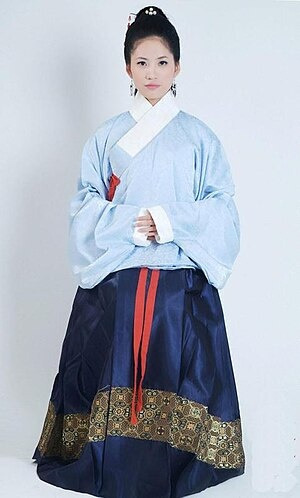
And they could absolutely be used by the nobles who could also make them incredibly pretty and of higher quality material so it wouldn't even look out of place in parties and the like.

You can even throw another bigger overcoat and make it look way more hanfu (more formal and imperial court approved)
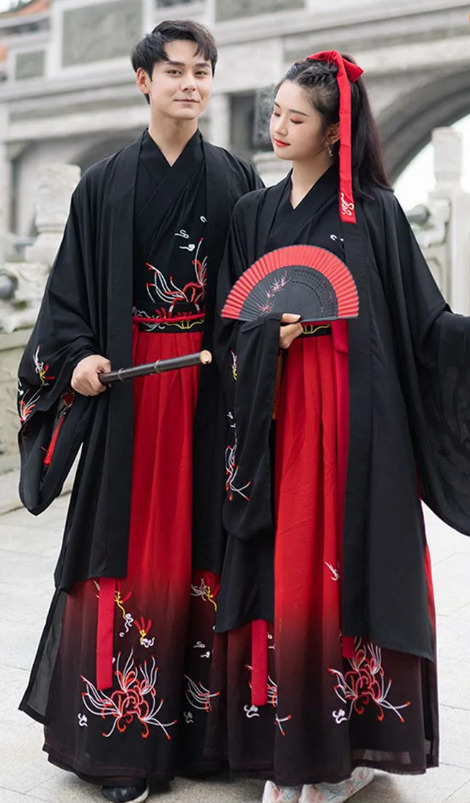
Of course, while the above is still used (and can be worn by our Champion as well if they wish as it is considered a middle ground for the traditionalists and progressives) by the empire, there is a divide currently going through fashion (and of course socially) of those staying true to their heritage and those wanting to experiment in accordance to influences from their regions (Ulthred, Moresaine, Beautrix, Swainea, Trevalyn, and now Lymark).
As such, western style of dresses and suits have begun to spread from Jelaytha and Trevalyn, who are ALSO the most merchant-like and most adventurous folk in the empire who travel around bringing their fashion and ideals to the rest of the empire.
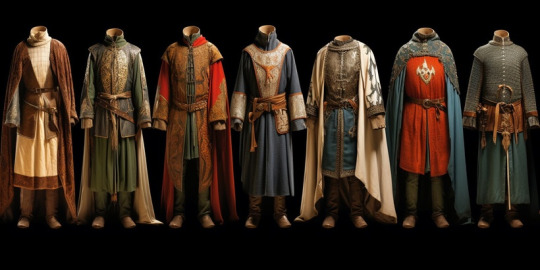

This dynamic has resulted in a wide variety of styles of hanfu and ruqun/fashion and what can be considered traditionally western-style gowns and suits.
For instance, this can create a situation where a traditionalist house may use sewing, weaving, and construction techniques the Jelaythans and Trevalyn people have created to make hanfu and ruqun outfits like below that show off their house sigil (in this case a deer). Talk about hypocrites lol

As an author, I really want to use the different regions of the empire (for it is huge and a mix of different cultures and peoples) to help explain/explore the vast history of Chinese fashion. So I may fuck around and describe an outfit that may not be period-appropriate but meh it's fantasy and the only people who'd get pissed are people super interested in a niche subject who really shouldnt get angry when im bringing this to a lot of more people lol
An artist named lilsuika (

#worldbuilding#choice of games#interactive fiction#interactive novel#kingdomsandempires#hosted games#choicescript#dashingdon#fantasy worldbuilding#fantasy world
122 notes
·
View notes
Text

Empress Sun (c. 1403–1462) was an ambitious and calculating woman who used her influence to shape the political events of her time.
The ambitious consort
Empress Sun’s father was an assistant magistrate in Yongcheng district. Her beauty and intelligence caught the attention of Lady Pengcheng, the mother of Crown Prince Zhu Gaochi’s wife, Lady Zhang.
Lady Zhang agreed to bring the young girl to the palace, where she received an education and earned the admiration of the palace women. In 1417, she became a consort of Zhu Zhanji, grandson of the Yongle Emperor. When Zhu Zhanji ascended the throne in 1425 as the Xuande Emperor, Sun was elevated to the highest consort rank, making her second only to the empress.
An empress falls, another rises
Consort Sun was known for her cunning and ambition. The empress, Hu Shanxiang, was in fragile health and had not given birth to a son—both factors that led her to fall out of favor with the emperor. In 1427, Sun gave birth to a son, Zhu Qizhen. However, some sources suggest the child may have been the son of a palace servant impregnated by the emperor, with Sun allegedly taking the baby as her own.
In 1429, in an unprecedented move, the Xuande Emperor deposed Empress Hu, granting her an honorific title. Sun was then elevated to the rank of empress. The decision was controversial. Empress Dowager Zhang sympathized with the deposed empress and often seated Hu in a place of honor during banquets—much to Sun’s displeasure.
As empress, Sun held court in her residence. She evaluated palace personnel, approved budgets, and arranged the marriages of princes and princesses. She also received visits from the other consorts and reported regularly to Empress Dowager Zhang.
Empress dowager
When the Xuande Emperor died in 1435, his son Zhu Qizhen was still a child. The ministers asked Empress Dowager Zhang to take charge of the regency, which she did unofficially, ushering in a period of peace and stability.
Empress Sun became empress dowager. In 1449, when the emperor was captured during a battle against the Mongols, Empress Sun ordered his half-brother, Zhu Qiyu, to take charge of state affairs. She tried to pay the emperor’s ransom without success but sent him warm furs and clothes during his captivity.
When Zhu Qizhen was finally released a year and a half later, his brother confined him to the palace and ruled in his place. Empress Sun was dissatisfied with the situation. In 1457, she played a key role in a coup that restored Zhu Qizhen to the throne—a turn of events that would not have happened without her influence and summons.
Empress Sun died of an illness in 1462.
If you enjoy this blog, consider supporting me on Ko-fi!
Further reading:
Lin Yanqing, “Sun, Empress of the Xuande Emperor, Xuanzong, of Ming”, in: Lee Lily Xiao Hong, Wiles Sue (eds.), Biographical Dictionary of Chinese Women, Volume II: Tang Through Ming 618 - 1644
McMahon Keith, Celestial Women: Imperial Wives and Concubines in China from Song to Qing
#empress sun#15th century#history#women in history#historyedit#women's history month#ming dynasty#china#chinese history#asian history#powerful women#empresses
77 notes
·
View notes
Note
Once upon a time, the great Chinese seafarer Zheng He returned from one of his voyages with a giraffe, causing surprise, shock, and growing confidence in the administration of the ruling Yongle Emperor for a simple reason: this previously unknown animal was identical to the mythical Qilin, and the admiral just finding one while on a voyage ordered directly by the Emperor could only mean divine approval.
In light of this, I like to imagine that there's no Qilin Miraculous, only a Giraffe one that some members of the Order insist calling the Qilin Miraculous.
Huh. Fascinating
19 notes
·
View notes
Text









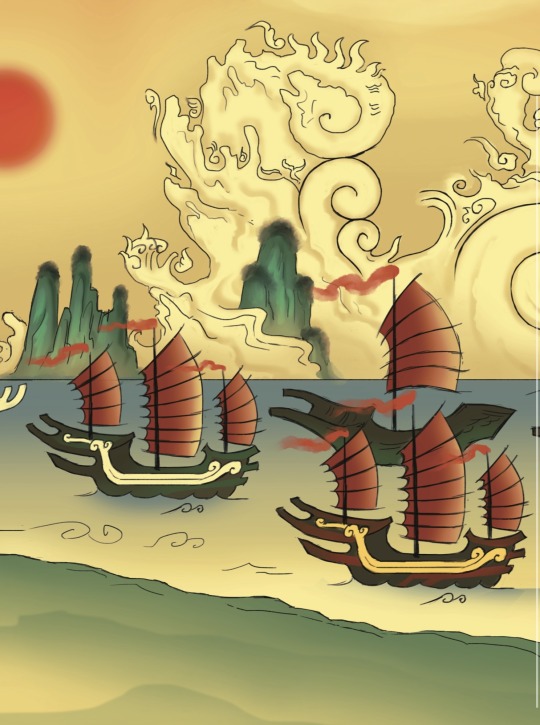
Zheng He, trading silks and Ming dynasty porcelain through Malindi, Mogadishu and all the African coast. Receiving in turn their unique wildlife and a giraffe as gift for the Yongle emperor, and a great way to boast the size of their fleet and massive ships.
Obviously the art is greatly oversimplified and there’s more to be said, but I’d learnt a lot about scroll paintings and the incredible precision of work from this era.
Zheng He was a lot of fun to learn about and both of these cultures are very foreign to me so I hope my research paid off and I did these events justice.
This was comissioned work for a chinese restaurant, named for Zheng He, in Podgorica.
Did this while i was still in college, a full year ago, and awaited updates from the restaurant.
It’s mural kinda huge and printed, appropriately, on silk across an entire wall. Looks all fancy! The ambient very cozy and nice.
Palette and concept by their interior designer and my college professor at the time.
#digital art#art#illustration#digital illustration#digital painting#digital artist#historical art#zheng he#chinese restaurant#qilin#ming dynasty#comissioned art
7 notes
·
View notes
Text



Sword (jian) and scabbard, probably made in the court workshops of the Yongle Ming Emperor. Chinese, Ming Dynasty, early 15th century.
The hilt is of gilt iron. The grip is of gibbous rectangular section, punched with small circles to imitate ray skin. Down the centre of the front is a raised spine bordered by tiny flames at either side.
The pommel is of trilobed form, bordered at the front and rear by bands of golden scrolls. The front panel of the pommel is chiselled and fretted with a dragon surrounded by interlacing flames, with triple claws on each paw. At the rear of the pommel, the central panel is decorated with a monster mask (kirtimukha), surmounted by a silvered crescent and golden disc, and with human hands, also surrounded by flames. At either side of the pommel are the Eight Buddhist Emblems of Good Augury (ba jixiang): the wheel of law (dharma), the standard, the treasure jar, the pair of fish, the endless knot, the lotus, the parasol and the conch shell of victory.
The guard is embossed in the form of a monster mask, surmounted by a silvered crescent and golden disc. The face is punched with circles, the canine teeth silvered, the eyebrows and whiskers chiselled and gilt. The horns are in the form of crab claws. At either side of the mouth is a paw in the form of a human hand. The head is surrounded by scrolling curls of mane. The rear of the guard is rendered as the underside of the jaw, with a set of silvered teeth, and a narrow beard running into a throat of alternate silvered and gilt bands.
The blade is associated but is probably a later replacement of Tibetan manufacture. It is formed of pattern-welded steel, of diamond section, straight and double edged. The pattern welding produces a mirrored pattern of addorsed crescents at either side of the medial ridge. The tang is of rectangular section, tapering towards the pommel, with a large expanded peg-hole towards the end. The edges have been ground and sharpened.
The scabbard is of wood covered in green stained leather and bound with gilt iron. At the throat is a V-shaped cut out at the front for seating the blade, and a scalloped cut-out in the leather to accommodate the guard. The throat retains traces of the scarlet silk with which it was lined. The iron binding comprises a long, facetted strip running all the way round either edge.
There are eight transverse bands at the rear, the uppermost and fourth of which are wider than the others, and extend round the front of the scabbard forming suspension loops. The edging strip has four main facets, with an additional narow facet at either side. It is decorated with scrollwork in gold running down each facet, and matching that on the pommel. At either end is a set of three golden lotus leaves.
The front panel is divided stylistically into upper and lower sections. The upper section is decorated quite plainly; a series of five beaded transverse bands divide it into six sections, and there are three vertical bands of fretted four-petalled rosettes in each section.
At the throat is a cusped section with a beaded border, below which is a band of flames. The ornate lower section has six smaller segments, divided vertically and horizontally by fretted 'vajras', each with a 'yinyang' symbol in the central knop. The half-'vajras' at either side emanate from the heads of lions, and the vertical bands of decoration at either side are formed by rows of flames.
Above and in the middle of these divisions are two square panels, each containing a cusped lozenge shaped central medallion, the corners decorated with interlacing flames. The uppermost of these two panels contains two dragons intertwined amid flames, with the heads at top right and bottom left; the lower has two similar dragons, with thicker bodies, and with their heads confronted at the left and right.
The chape section is decorated with a large panel of interlacing flames, within a beaded border. At the rear of the scabbard, the upper band is decorated with alternating gold and silver scrollwork, and terminates in a rosette at the front. The next two narrow bands are decorated with silver scrollwork only. The fourth is decorated at the rear like the top one, but is extended accross the front in a broad band; it is chiselled with four medallions decorated with gilt characters on silver grounds, and surrounded by interlacing gilt flames. The three lower bands are decorated in gold scrollwork.
The rear chape panel has a small, flat piece of rather coarse, scrolling interlace at the bottom, and narrow bands of petalled rosettes at either side.
A four character Tibetan inscription on the lower suspension loop reads 'khi'u ga ral gri' (honourific sharp sword).
China, 15th century (About 1420),
Leather, Ferrous, Gold, Silver, Semi-precious stone, Silk, Wood,
Dimensions:
Blade Length: 30 inches
Overall (sword) Length: 35 inches
Courtesy: Royal Armouries Museum, Leeds, United Kingdom
Sword (jian) and scabbard, probably made in the court workshops of the Yongle Ming Emperor. Chinese, Ming Dynasty, early 15th century.
#art#history#design#style#sculpture#silver#gold#semi precious stones#royal armouries#leeds#silk#wood#sword#jian#scabbard#ming#15th century#yongle#imperial
77 notes
·
View notes
Text

MWW Artwork of the Day (2/22/25) Ming Dynasty, Wanli Reign (China, 1572-1620) Man, blowing a conch, seated on an animal (c. 1600) Jingdezhen ware, underglaze blue ceramic statue The Shanghai Museum
The Ming Dynasty saw an extraordinary period of innovation in ceramic manufacture. Kilns investigated new techniques in design and shapes, showing a predilection for color and painted design, and an openness to foreign forms. The Yongle Emperor (1402-24) was especially curious about other countries (as evidenced by his support of the eunuch Zheng He's extended exploration of the Indian Ocean), and enjoyed unusual shapes, many inspired by Islamic metalwork. During the Xuande reign (1425–35), a technical refinement was introduced in the preparation of the cobalt used for underglaze blue decoration.
4 notes
·
View notes
Text
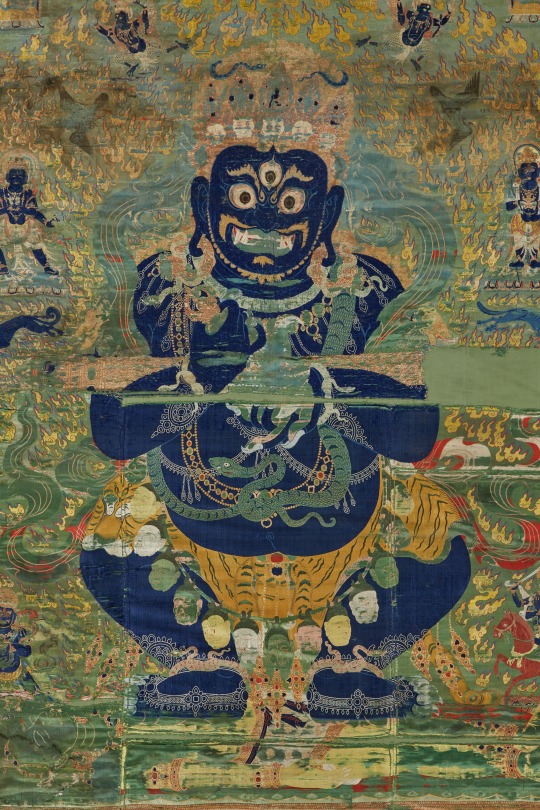
A monumental Imperial silk brocade thangka of Mahakala, Yongle period
134 x 87 inches, 340 x 221 cm. Estimate: US$800,000-1,200,000.
Failed to sell Sotheby's, New York, 21 March 2024.
The textile was produced in the Imperial workshops of the Yongle Emperor (1360-1424) during his reign (1403-1424) as a gift to a high-ranking Tibetan lama and depicts Mahakala Panjarnatha.
If you want to look at a big image just copy the following into a new window:
http://sothebys-brightspot.s3.amazonaws.com/media-desk/92/a6/b53249fa445296fb14d3fde38e37/n11418-cxsj2-t1-02.jpg
I posted another artwork depicting Mahakala back in 2019. You'll find it by clicking any of the tags below. Again, you can look at a big image.
17 notes
·
View notes
Text
Empress Xiaogongzhang of the Ming Dynasty (1428-1435)

Lady Sun was born in 1399 in Zouping and was known as the local beauty. She was brought into the palace by the then Crown Princess Zhang who had heard about Lady Sun’s beauty. She was educated by Empress Xu, wife of the Yongle Emperor, and was selected to be a concubine for Zhu Zhanji, the grandson-heir, in 1417.
When Zhu Zhanji ascended the throne in 1425, Lady Sun was named Noble Consort Sun, the second highest ranking position of the harem. The emperor had always favored Lady Sun over Empress Hu and this would lead to Empress Hu’s downfall. In 1427 Lady Sun would give birth to a son, Zhu Qizhen, who was named the crown prince. The emperor began looking for ways to depose Empress Hu, who was known to be sickly and had no sons, and install Lady Sun as Empress. Lady Sun would attempt to dissuade the emperor from doing this but eventually relented and in 1428 she was named Empress.
When the Xuande Emperor passed away in 1435 he was succeeded by Zhu Qizhen, who became the Zhengtong Emperor. As the Zhengtong Emperor was only eight years old he needed a regent. The now Empress Dowager Sun and the Grand Empress Dowager Zhang would fight over who would head the regency and the Grand Empress Dowager would win over Lady Sun. Lady Sun was sidelined and even censured by the imperial historians for trying to influence government affairs.
In 1449, tragedy would strike when the Zhengtong Emperor was captured by the Mongols in battle. Lady Sun and her daughter-in-law, Empress Qian, would pay the ransom in full but the Mongols rejected it and decided to hold the emperor hostage. Officials from the court decided to make the emperor’s younger half brother, Zhu Qiyu, the Jingtai Emperor. In the beginning, Zhu Qiyu would refuse the throne but after Lady Sun urged him to accept he would ascend the throne.
The Mongols would quickly release Zhu Qizhen after this, knowing that two emperors would cause chaos among the Ming. The Jingtai Emperor was quick to place the former Emperor under house arrest, where he would stay for the next six years. Lady Sun and her brothers would head a coup that put her son back on the throne as the Tianshun Emperor.
Lady Sun would pass away from illness on 26 September 1462.
Titles:
Lady Sun (from 1399)
Concubine of the Imperial Grandson-heir (from 1417)
Noble Consort Sun (from 1425)
Empress (from 1428)
Empress Dowager (from 1435)
Empress Dowager Shangsheng (from 1449)
Empress Dowager Shengliechishou (from 1457)
Empress Xiaogongzhang (posthumous from 1462)
5 notes
·
View notes
Text
[Hanfu · 漢服]Chinese immortal Hanfu <灵芝玉女/Goddess holding Ling Zhi> Based On Yuan Dynasty Taoist Temple Mural<永乐宫/Yongle Palace>







【Historical Artifact Reference】:
▶ China Yongle Temple(永乐宫) Murals showing<灵芝玉女 / Goddess holding Lingzhi>
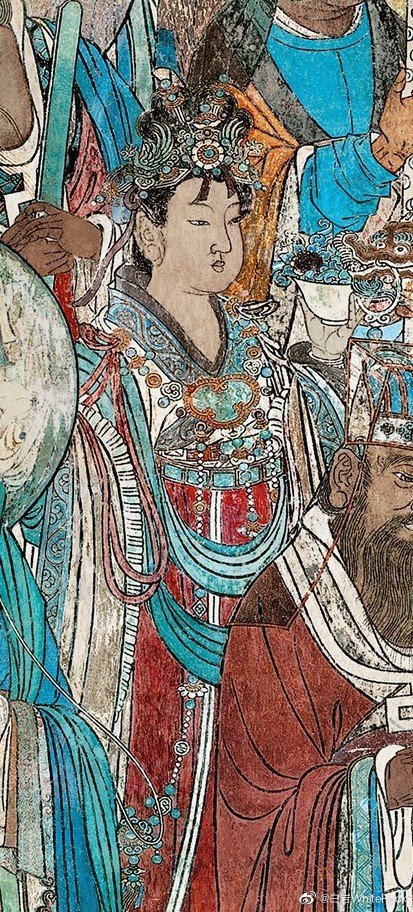

🍄The significance of Lingzhi in China🍄
In Chinese art, the lingzhi symbolizes great health and longevity, as depicted in the imperial Forbidden City and Summer Palace.It was a talisman for luck in the traditional culture of China, and the goddess of healing Guanyin is sometimes depicted holding a lingzhi mushroom
The Old Chinese name for lingzhi 靈芝 was first recorded during the Han dynasty (206 BC – 9 AD). In the Chinese language, língzhī (靈芝) is a compound. It comprises líng (靈); "spirit, spiritual; soul; miraculous; sacred; divine; mysterious; efficacious; effective)" as, for example, in the name of the Lingyan Temple in Jinan, and zhī (芝); "(traditional) plant of longevity; fungus; seed; branch; mushroom; excrescence"). Fabrizio Pregadio notes, "The term zhi, which has no equivalent in Western languages, refers to a variety of supermundane substances often described as plants, fungi, or 'excrescences'."Zhi occurs in other Chinese plant names, such as zhīmá (芝麻; "sesame" or "seed"), and was anciently used a phonetic loan character for zhǐ (芷; "Angelica iris"). Chinese differentiates Ganoderma species into chìzhī (赤芝; "red mushroom") G. lingzhi, and zǐzhī (紫芝; "purple mushroom") Ganoderma sinense.
In the chronicles of Shiji (1st century CE from Sima Qian), the initial use of nearby separately related words with Chinese: 芝 and Chinese: 靈 are attested to in the poems of Emperor Wu of Han. Later, in the 1st century CE through the poetry of Ban Gu, occurred the first combination of the characters 靈芝 together into a single word.
_______________
📸Photography post-production :@小何力
👗Hanfu & 👑Crown:@雁鸿Aimee
👭Model:@清音音音音
💄 Makeup:百丽 (临溪摄影)
🔗Weibo:https://weibo.com/1615560544/O267AzTqM
_______________
#chinese hanfu#immortal hanfu#hanfu#hanfu accessories#hanfu_challenge#chinese traditional clothing#china#chinese#chinese style#chinese mythology#漢服#汉服#中華風
195 notes
·
View notes